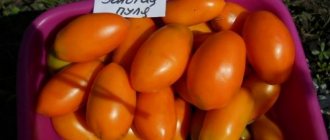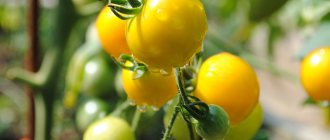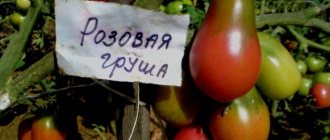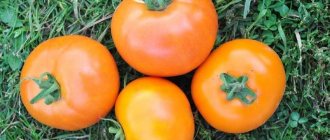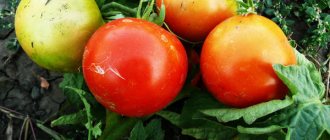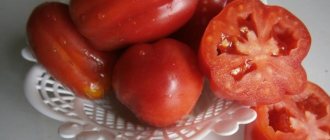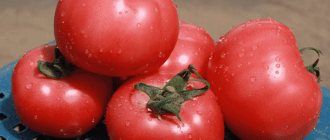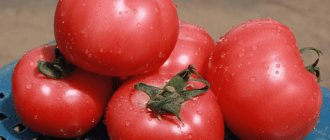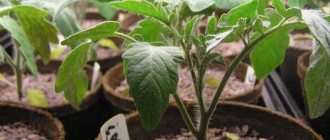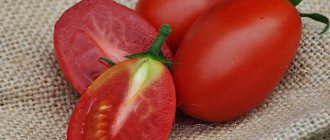Tomatoes “Golden Mother-in-law”: description of the variety
| Variety name | Golden mother-in-law |
| general description | Early maturing, high-yielding hybrid of the first generation |
| Originator | Russia |
| Ripening period | 85-90 days |
| Form | Flat-round with slight ribbing |
| Color | Yellow |
| Average weight of tomatoes | 120-150 grams |
| Application | Universal |
| Productivity of the variety | 2.5-4 kg per square meter |
| Features of cultivation | Standard agricultural technology |
| Disease resistance | Resistant to most diseases |
The hybrid tomato variety “Golden Mother-in-law” was bred by Russian breeder Lyubov Myazina and included in the state register of varieties in 2008.
This is a hybrid of the first generation F1, that is, obtained from crossing two other varieties and possessing the maximum set of qualities that the breeder wanted to put into it. “Golden Mother-in-Law” is an early variety; it takes 85–90 days from germination to the first ovaries. The bush is determinate, with a small number of leaves. About 80 cm in height. Read about indeterminate varieties here.
The hybrid shows high resistance to some common tomato diseases: tobacco mosaic virus (TMV), dry spot (alternaria) and bacteriosis (bacterial canker). The early ripening of fruits makes the Golden Mother-in-law hybrid suitable for cultivation in most regions of our country.
The variety is suitable for both open ground and greenhouses. The manufacturer primarily recommends film greenhouses, but in glass greenhouses “Golden Mother-in-Law” also shows excellent productivity.
How to get seedlings
Designed for cultivation in open ground, but also possible in greenhouses (preferably film ones). Everything from the moment of sprouting to the ripening of tomatoes takes 85-90 days.
Approximately 9-12 days for planting and establishment of seedlings, plus 2 months for seedling germination (45-55 days) and several weeks for fruit ripening.
For open ground, seedlings are prepared from mid-March or in the 1st ten days of April.
Seed preparation:
- Dry seeds need to be washed in potassium permanganate. To prepare a solution (0.5%) you will need 200 ml of water and 1 gram of pharmaceutical manganese in crystals.
- Leave them in it for 15-20 minutes and rinse with plenty of water.
- Then soak for a couple of hours in a hormonal extract to accelerate germination for 4-5 days.
These manipulations will increase survival rate and protect seedlings from diseases in the first few weeks.
Although, you can do without pre-sowing treatment, if you are sure that this is a proprietary product in a closed shell, it was stored correctly and did not miss the expiration date.
Next, the seeds are placed in a separate container with water, which is covered with gauze so that they do not float.
Container and soil
The container for seedlings can be any size , be it a large container or individual 100 ml pots. The distance between seedlings is small (from 2 cm), the roots are poorly developed, but the main thing is that sufficient oxygen access is ensured. And after the first two true leaves appear, the roots begin to grow and require 4 times more space. Transplant into containers or individual pots up to 500 ml.
Sowing:
- There is no need to wait for the seed to germinate and, on the second day, plant it in special universal fertile soil about 2 cm deep.
- It is important that the sprout itself sheds its skin after sprouting outward, so each hole needs to be lightly compacted.
- The sowing is covered with film, but care is taken to ensure that the seeds do not steam. The temperature must be at least 15°C and no more than 25°C.
- When the shoots appear, the film is removed and the temperature is reduced to 16° C during the day and 14° C at night, this is done for the full growth and development of the root system. It is these temperature indicators that contribute to the proper absorption of minerals.
It is important that there is enough not only moisture, but also light. In February-March, seedlings should be illuminated for at least 12 hours during the day.
Aftercare
In the next stage, the plants are transplanted into new pots, at the same time diving the roots (by 1-2 cm) to grow in width and the appearance of lateral shoots.
This is an important point. Reducing part of the root system makes the plant older and speeds up the ripening period of tomatoes.
- 2 hours before transplanting, the soil needs to be moistened in order to remove the sprout more carefully. A teaspoon or toothpick is used as a tool.
- Immediately after picking and transplanting, it is necessary to start feeding with nutritional mixtures, and to increase the mass of the roots, lower the temperature. Therefore, the pots are moved to a dark place for a couple of days.
- A week or two before transplanting into open ground, young plants are hardened off by taking them out into the open air for several hours, fertilized less with nitrogen and watering is reduced.
Characteristics
The fruits of this hybrid set light green and become a beautiful yellow-orange color when ripe. In size - medium, weighing up to 200 grams, usually 120-150g. The tomatoes look very aesthetically pleasing, on the bush they are collected in dense clusters and ripen together. On the rounded, smoothed fruit, ribs are visible that separate 4 chambers with seeds. The fruit is dense. It stores well and is not prone to cracking with changes in temperature and humidity.
The table below will help you compare the weight of the fruits of the Golden Mother-in-law variety with others:
| Variety name | Fruit weight |
| Golden mother-in-law | 120-150 grams |
| Miracle Lazy | 60-65 grams |
| Sanka | 80-150 grams |
| Lyana Pink | 80-100 grams |
| Shchelkovsky Early | 40-60 grams |
| Labrador | 80-150 grams |
| Severenok F1 | 100-150 grams |
| Bullfinch | 130-150 grams |
| Room surprise | 25 grams |
| F1 debut | 180-250 grams |
| Alenka | 200-250 grams |
In open ground, up to 2.5 kg of fruit can be collected from one bush; in a greenhouse, the yield is higher - up to 4 kg. The hybrid breeder speaks of “Golden Mother-in-Law” as a universal variety, suitable for both fresh consumption and canning, processing into juice or tomato paste. And if only convinced aesthetes are ready to make paste from yellow fruits, then these golden, slightly sour tomatoes are very good in a salad. The dense skin prevents the fruit from cracking even during preservation.
Yield indicators for other varieties can be found below:
| Variety name | Productivity |
| Golden mother-in-law | 2.5-4 kg per bush |
| Raspberry ringing | 18 kg per square meter |
| Red Arrow | 27 kg per square meter |
| Valentina | 10-12 kg per square meter |
| Samara | 11-13 kg per square meter |
| Tanya | 4.5-5 kg per bush |
| f1 favorite | 19-20 kg per square meter |
| Demidov | 1.5-5 kg per square meter |
| Beauty King | 5.5-7 kg per bush |
| Banana Orange | 8-9 kg per square meter |
| Mystery | 20-22 kg per bush |
Advantages and disadvantages
The variety combines many positive qualities. Starting from an appetizing appearance and ending with high yield under not the most favorable conditions of the Russian summer.
- Does not cause allergies, is universal when used.
- Excellent for diet and children's menus due to the increased content of antioxidants.
- It has immunostimulating and adaptogenic properties.
The disadvantage is that seeds cannot be collected from hybrid fruits , since they produce completely different and often non-viable plants. Seeds are obtained by crossing two varieties, which means only from first generation seeds. To get them you have to pollinate the opened flowers by hand.
Photo
Below are several photographs of the hybrid tomato variety “Golden Mother-in-law”:
Features of cultivation
“Golden Mother-in-Law” is a hybrid characterized by good productivity and excellent health. It does not require special growing conditions, but, like all tomatoes, it prefers neutral or slightly acidic soil with a pH of 6–7, rich in organic matter, protected from wind and direct sunlight in a place with relatively dry air.
Tip: Seed treatment before planting is not required. Seedlings are planted in the ground approximately 55 days after emergence. A 40x70 planting pattern is recommended.
When grown in a greenhouse, pinching and tying will be required. It needs to be done every 5-7 days. It is better to remove stepsons in the morning, in dry weather. If tomatoes are grown on a trellis, then the stepson from under the fourth or fifth inflorescence can be left and then grow the bush into two stems. Plants in open ground do not need to be pinched, but you will have to wait a little longer for ripe fruits.
You can feed tomatoes with organic matter or ready-made complex fertilizers, maintaining the balance of nitrogen, potassium and phosphorus. Flowering can be stimulated by spraying with a solution of boric acid. Modern growth stimulants, for example, HB 101, are also popular among gardeners.
How to grow tomatoes
The seedlings must be at least 50 days old, and the soil (at a depth of 12 cm) must be warmed to at least 12 C day and night.
At the time of transplantation, the seedlings already look quite strong, developed roots have entwined the entire pot, a thickened trunk, dark green leaves, a bud or a blossoming flower on the first cluster.
The planting site is chosen based on the sunniest and highest space on the site. Poor lighting reduces the sugar content and weight of the fruit.
Landing
A damp and cloudy day or evening is best for transplanting.
You can plant seedlings in a greenhouse or directly in open ground according to the 40x70 cm pattern.
The more stems, the greater the distance between bushes.
Disembarkation:
- A glass of ash, humus, and special complex fertilizers from the store are poured into the hole.
- Then fill it with water, maybe more than once, so that the consistency of the soil is like sour cream.
- The bush (possibly with a clod of earth) is planted deep to the level of the first true leaf.
- At the roots, the soil with the roots must be squeezed with your fingers.
- Stepchildren (shoots from the axils of the stem) need to be removed, even very small ones.
The best bushes are planted in a row, and it is better to leave the weak ones at the edges. It is important to be careful, as infection can easily enter through injured roots.
Care
It is recommended to mulch with dry grass, shavings, husks, sawdust, straw or inorganic materials (polyethylene with holes, agrofibre, etc.).
A protective layer of mulch fights pests and weeds, prevents overheating and compaction. Each stem needs a garter .
In order not to damage the roots, the peg should be at a distance (15-20 cm) and higher than the bush. The trunk is tied around the stems with ropes or ribbons crossed in a figure eight. There is no need to water or loosen the first 10 days after planting tomatoes.
Hilling is scheduled for the second week after transplantation.
- In the early morning (2 hours before dawn) or late evening, water the soil so that it is soft enough.
- Weeds are pulled out by hand.
- Loosen with a convenient tool.
- Sprinkle the trunk with a mound of loose earth in the form of a mound of about 20 cm.
This process is usually combined with humus fertilizer. You can repeat the activity every week after watering or rain.
Fertilizing with any microelements is done when the first true leaf appears , sprayed 2-3 hours after watering. There is no need to fill the tomatoes. Once every 5-10 days is enough, depending on the weather, and if you notice that the leaves are a little wilted.
Possible difficulties
From an excess of water, the seeds begin to suffocate, so the seedling pots should spill through, and the excess water should flow freely into the pan.
Water only with warm, settled (without bleach) clean water. It is useful to unfold and swap pots to change the lighting angle .
You can also put something under them if the window sill is cold. Correct actions in the initial period of caring for seedlings are actually much more important than all other activities with an adult plant. You cannot plant tomatoes next to potatoes, because they are the first to be affected by late blight. Excess dampness and moisture can cause flowers to fall off, delayed fruit set and the appearance of fungus. 3-5 liters of water per bush is enough, and during flowering generally reduce watering to 1-2 liters. But they don’t like to drink tomatoes more than twice a week.
Diseases and pests
Prone to late blight - the fruits are covered with brown and brown spots, the stems and leaves have dark stripes, and the bottom of the leaf is covered with a white fungal coating. They are treated with special preparations – fungicides. Picked fruits can also be susceptible to fungus.
Prevention consists of moderate amounts of fertilizer and water . Avoid crowding of bushes and immediately remove and burn all diseased plants.
Parasites like to eat leaves and stems:
- Colorado potato beetles;
- slugs;
- spider mites;
- whiteflies;
- caterpillars;
- aphid.
Insecticides are used to control insects.
Nuances for open ground and greenhouses
When growing in a greenhouse, avoid condensation and ventilate from the direction opposite to the wind direction. If it rains, the greenhouse is not watered. Excess moisture directly affects the taste, making tomatoes more bland.
Diseases and pests
Among the diseases of tomatoes, it is first of all worth noting late blight, to which this hybrid is not resistant. This fungal disease can destroy the entire crop of tomatoes and other nightshades on the site. To prevent late blight, you should first of all avoid crowding of plantings, flooding the soil and overfeeding with fertilizers. Read more about protection against late blight and varieties resistant to it.
Spraying with copper sulfate, Ridomil and other fungicides is also effective. Affected plants must be immediately removed from greenhouses or beds and burned.
Farmer reviews
Many gardeners have already tried this variety for growing on their site and were satisfied with the result. Among the positive qualities, the following stand out:
- high quality taste;
- tomatoes ripen quite quickly;
- interesting appearance of the fruit;
- high productivity;
- immunity to certain types of diseases of vegetable crops.
Directly similar reviews about the Golden Mother-in-law tomato can be heard from people who have dealt with the tomatoes described.
Video
We also bring to your attention other varieties of tomatoes with different ripening periods:
| Mid-early | Super early | Late ripening |
| Timofey | Alpha | Premier |
| Ivanovich | Pink Impression | Grapefruit |
| Bullet | Golden stream | De Barao the giant |
| Russian soul | The Lazy Man's Miracle | Yusupovsky |
| Giant red | Pickling miracle | Altaic |
| New from Transnistria | Sanka | Rocket |
| Sultan | Labrador | American ribbed |
If you find an error, please select a piece of text and press Ctrl+Enter.
